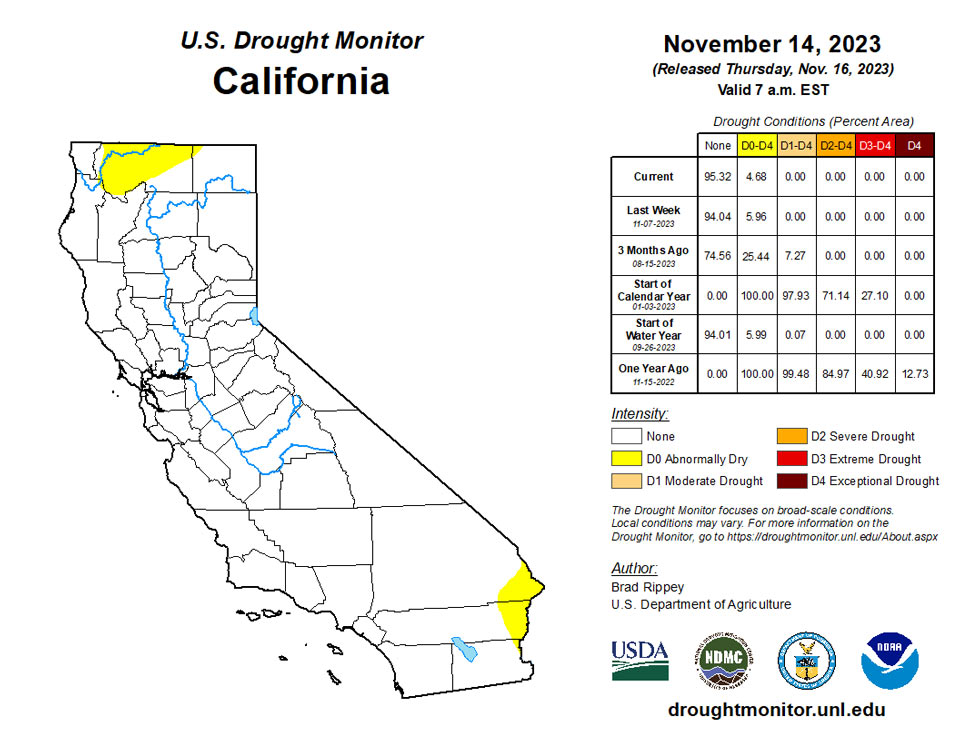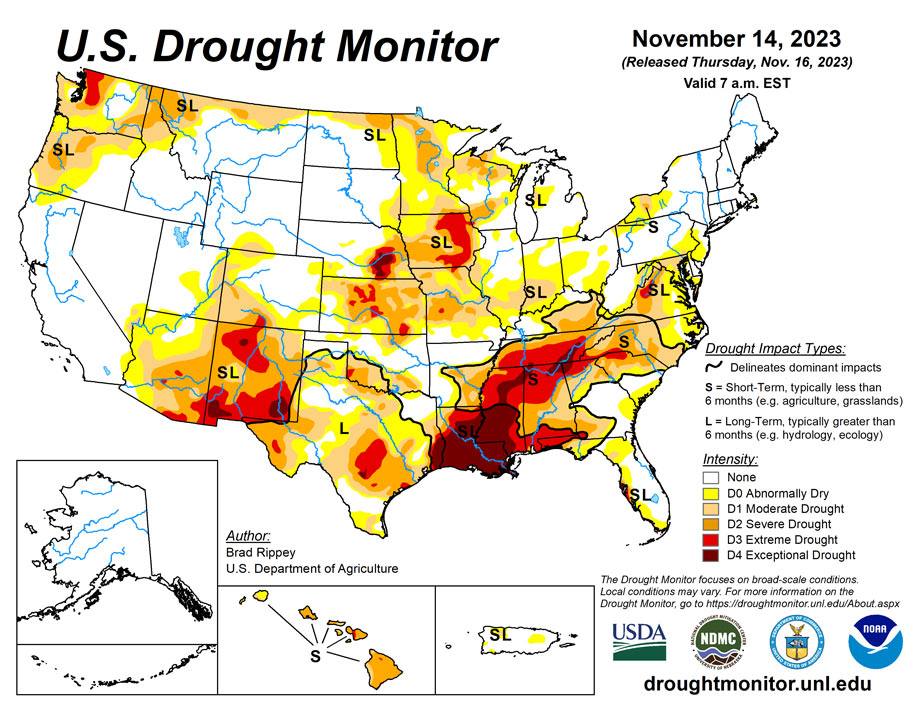
California and National Drought Summary for November 14, 2023
Summary
November 16, 2023 - During the drought-monitoring period ending November 14, precipitation was focused across a few geographic areas, including portions of the Northwest, South, and Great Lakes region. In places where precipitation fell, winter grains, cover crops, and rangeland and pastures generally benefited from the boost in topsoil moisture. That was especially true in the South, which has been contending with serious “flash drought” issues, including a rash of autumn wildfires. However, Southern rainfall coverage was spotty, with many areas receiving only light showers. Elsewhere, Northwestern precipitation was heaviest from the Cascades westward, although key agricultural areas farther inland received some moisture. Following a nearly nationwide cold outbreak in late October and early November, warmth returned across most of the country, amplifying drought impacts in some of the driest areas.
Northeast
Northeastern drought currently has a small footprint, but those areas experiencing dryness (D0) or moderate to severe drought (D1 to D2) generally received minimal precipitation during the drought-monitoring period. Some of the driest areas included parts of western New York and the eastern slopes of the central Appalachians. On November 12, the U.S. Department of Agriculture rated topsoil moisture 48% very short to short in West Virginia, along with 57% in Delaware and 48% in Maryland.
Southeast
Flash drought continued to rapidly develop and expand across the Southeast, with impacts on the emergence and establishment of fall-sown crops. In addition, Southeastern wildfires have been a problem in recent weeks, with dozens of large fires burning hundreds or thousands of acres of vegetation and fallen leaves. In Virginia, the Quaker Run Fire—partly burning in Shenandoah National Park—has scorched nearly 4,000 acres. In southwestern North Carolina, the Collett Ridge Fire has charred more than 5,300 acres. On November 12, Alabama led the nation with topsoil moisture rated 89% very short to short, according to the U.S. Department of Agriculture. Other Southeastern States above one-half very short to short were North Carolina (75%), Georgia (69%), South Carolina (65%), and Virginia (63%). During the week exceptional drought (D4) expanded further into northern sections of Alabama and Georgia.
South
Heavy rain in parts of Texas and along the Gulf Coast contrasted with mostly dry weather farther north and inland. Accordingly, one- to locally two-category improvements in the drought depiction were noted in western, central, eastern, and southern Texas, while other areas experienced either no change or one-category drought deterioration. In fact, exceptional drought (D4) expanded further into the Tennessee Valley and environs. On November 12, the U.S. Department of Agriculture rated topsoil moisture 88% very short to short in Louisiana, along with 84% in Mississippi. On the same date, pastures were rated 71% very poor to poor in Mississippi, along with 57% in Louisiana and 56% in Tennessee.
Midwest
Significant precipitation was limited to parts of the upper Great Lakes region, with the remainder of the Midwest experiencing mild, mostly dry weather. Those conditions were ideal for autumn fieldwork, with the U.S. soybean harvest 95% complete by November 12. In addition, 88% of the nation’s corn had been harvested on that date. However, soil moisture shortages remained a concern for some fall-sown crops, including winter wheat and cover crops. On November 12, topsoil moisture was rated more than one-half very short to short in Iowa (58%) and Missouri (53%), according to the U.S. Department of Agriculture.
High Plains
Pockets of drought were mainly focused across eastern and southern sections of the region, with worsening conditions noted in parts of Kansas and neighboring states. According to the U.S. Department of Agriculture, topsoil moisture was rated more than one-half very short to short on November 12 in Kanas (69%), Nebraska (61%), and Colorado (60%). On the same date, 17% of the U.S. winter wheat crop was rated in very poor to poor condition, although state-level numbers were higher in Kansas (33% very poor to poor) and Nebraska (18%).
West
Aside from modest improvements in the Northwestern drought situation, there were few changes in the depiction. Despite the recent Northwestern precipitation, some interior agricultural areas remained dry, with topsoil moisture rated (on November 12, by the U.S. Department of Agriculture) 55% very short to short in Washington, along with 41% in Oregon. In addition, more than one-quarter (29%) of Oregon’s winter wheat was rated in very poor to poor condition on that date. Farther south, New Mexico led the region on November 12 with topsoil moisture rated 75% very short to short, despite patchy precipitation during the drought-monitoring period.
Caribbean
In Puerto Rico, locally heavy showers in some northern and eastern locations further chipped away at any remaining dryness (D0) and moderate drought (D1). Following a 5.20-inch rainfall on October 27, San Juan, Puerto Rico, received at least a trace of rain on each of the first 14 days of November, totaling 3.11 inches.
The drought status of the U.S. Virgin Islands remains unchanged this week with St. Thomas and St. Croix at D2, severe drought, while St. John remains drought-free. Rainfall for the islands as reported by local observers was 0.48 inches for St. Thomas, between 1.72 and 5.60 inches on St. Croix, and 1.52 and 2.81 inches for St. John.
While ample rainfall on St. Croix would seem to favor improvement, the well level at a depth to water of more than 33.5 feet remained extremely low. The well has responded to recent rainfall by rising a little more than a foot over the past week, but was still very low.
The Standardized Precipitation Index for St. Thomas indicated mild to moderate dryness at all time scales. St. Croix was neutral at most time scales and mildly dry at 9 and 12 months. St. John was neutral or mildly wet on short time scales.
Pacific
A lingering patch of abnormal dryness (D0) was removed from Alaska, which received locally heavy precipitation. Snow was heaviest in parts of southern Alaska, where Anchorage measured 37.9 inches of snow (2.92 inches of liquid equivalency) during the first 13 days of November. The snowiest November in Anchorage occurred in 1994, with 38.8 inches.
In Hawaii, a significant autumn dry spell continued, with 94% of the state considered to be in drought for the second consecutive week. In early November, periods of gusty trade winds led to an enhanced wildfire threat. On Oahu, the Mililani Fire charred more than 1,600 acres of grass, brush, and forest. Kahului, Maui, clocked winds of at least 40 mph on 7 of the first 14 days of the month, including a peak gust to 48 mph on November 12. At the state’s major airport observation sites, November 1-14 rainfall ranged from 0.02 inch (2 percent of normal) in Honolulu, Oahu, to 2.06 inches (32 percent) in Hilo, on the Big Island.
The Republic of Palau received adequate rainfall with 2.29 inches at Palau IAP and 1.36 inches for Koror COOP.
The Mariana Islands all received less than an inch of rain, but have gotten enough in recent weeks to be free of drought. Guam received 0.76 inches, while Rota reported 0.74 inches. Saipan received 0.12 and 0.56 inches at Saipan ASOS and the IAP gauges. These islands need an inch weekly to meet minimum water needs.
The Federal States of Micronesia were mixed in terms of precipitation, but had no drought in the territory. Fananu, Lukunor, Pingelap, Ulithi, Woleai and Yap all received less than 2 inches of rainfall, according to the received data, but have gotten enough rain in recent weeks to have adequate water supplies. Chuuk and Kapingamarangi received more than 5.5 inches of rainfall in the past week, while Kosrae reported 11.20 inches.
The Marshall Islands all received more than 3 inches of precipitation for the week, with Ailinglaplap reporting 12.04 inches. The Majuro reservoir held 34.884 million gallons on Nov. 14. Weeks of improved rainfall for Wotje resulted in removal of D0, making all locations in the Marshall Islands free of dryness.
American Samoa remained free of dryness. Pago Pago, Siufaga Ridge and Toa Ridge all received less than an inch of rain, which is the amount these locations need to meet minimum water needs. Rainfall the previous week exceeded an inch, leaving them in good stead.
Looking Ahead
Mostly dry weather will prevail during the next several days across the nation’s mid-section, including the Plains and upper Midwest. Farther south, showers will continue to shift eastward along and near the Gulf Coast, with the potential for late-week rain and gusty winds in parts of Florida. During the weekend, a low-pressure system accelerating northward near the Atlantic Seaboard could result in coastal wind and rain in New England. Elsewhere, a storm system parked west of California will remain offshore for the next couple of days, although rain and snow showers will spread inland at times. Late in the weekend, some of the Pacific storm energy interacting with a surge of cold air arriving from western Canada should lead to an increase in rain and snow shower activity across parts of the western and central U.S., although precipitation will initially be light. The NWS 6- to 10-day outlook for November 21 – 25 calls for the likelihood of below-normal temperatures east of the Rockies, while warmer-than-normal weather will prevail in the West. Meanwhile, below-normal precipitation in most areas west of the Mississippi River should contrast with wetter-than-normal weather in the East, as well as northern sections of the Rockies and High Plains.
Author(s):
Brad Rippey, U.S. Department of Agriculture
Denise Gutzmer, National Drought Mitigation Center
Dryness Categories
D0 Abnormally Dry—used for areas showing dryness but not yet in drought, or for areas recovering from drought.
Drought Intensity Categories
D1 Moderate Drought
D2 Severe Drought
D3 Extreme Drought
D4 Exceptional Drought
Drought or Dryness Types
S Short-term, typically less than 6 months (agriculture, grasslands)
L Long-term, typically more than 6 months (hydrology, ecology)
SL Area contains both short- and long-term impacts

Source: National Drought Mitigation Center








